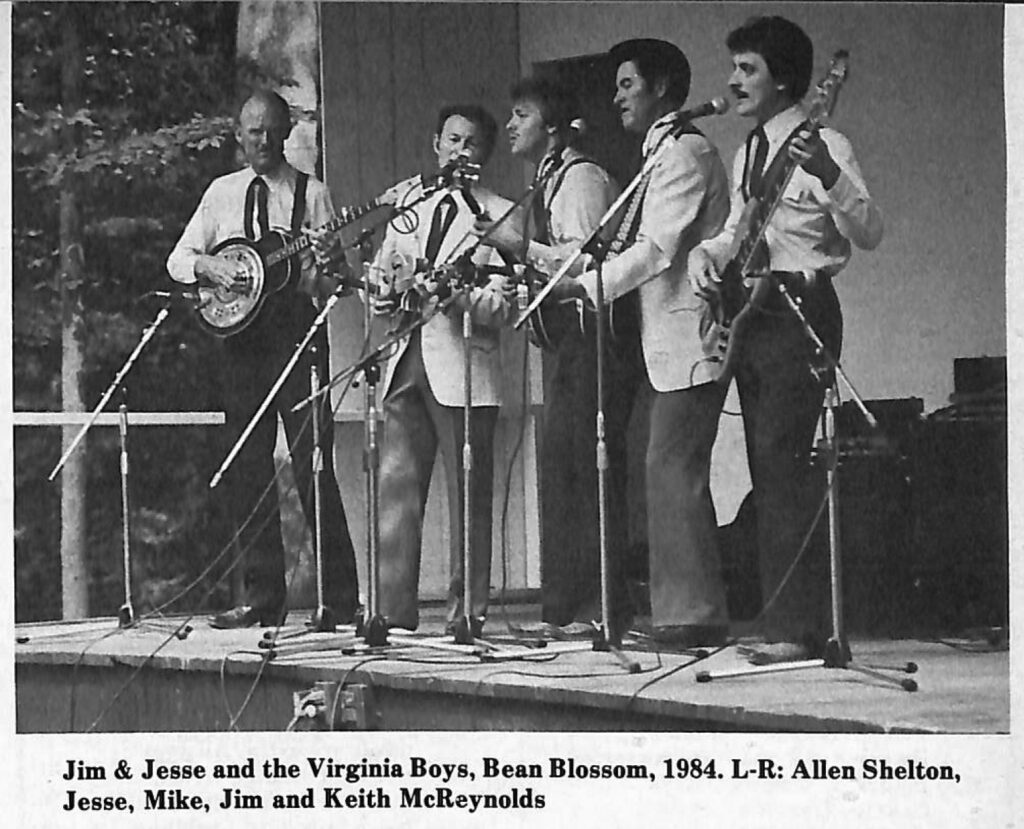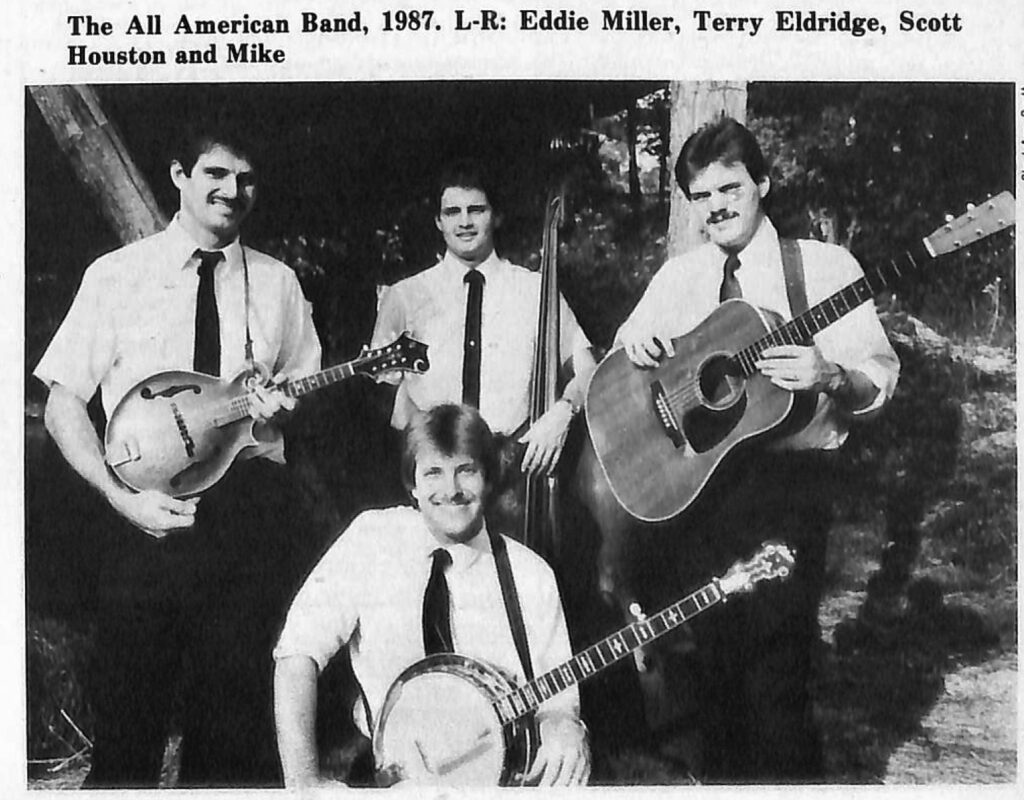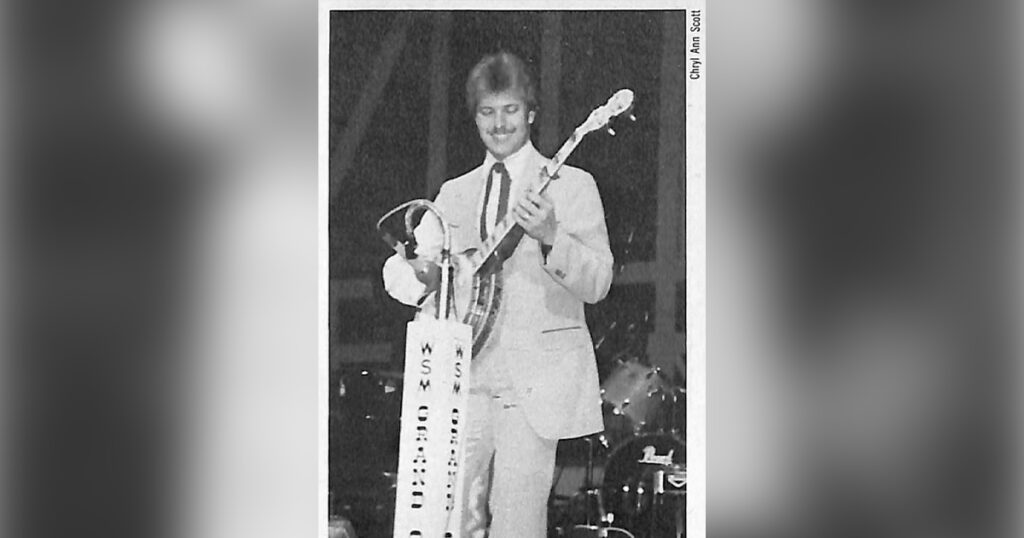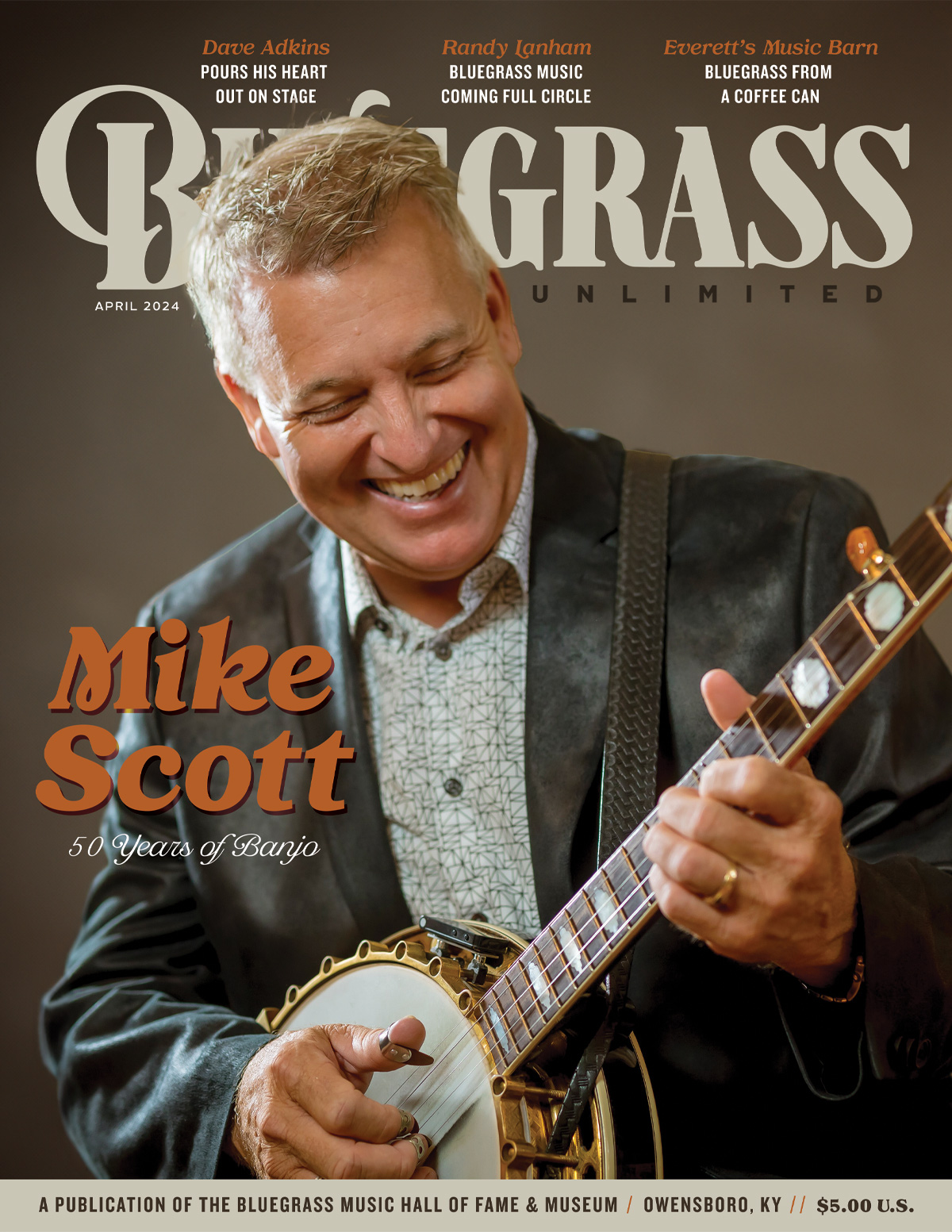Home > Articles > The Archives > Mike Scott — Preserving An American Tradition
Mike Scott — Preserving An American Tradition
Reprinted from Bluegrass Unlimited Magazine
February 1989, Volume 23, Number 8
Although it has been nearly two years since Mike Scott played banjo for Jim and Jesse and the Virginia Boys, he has not let his musical career remain idle. His experience with Jim and Jesse as well as his years with Carl Story and the Rambling Mountaineers provided him with an excellent foundation from which to build a musical career of his own.
Who could ever forget Mike’s unending smile which brightened the stage of Jim and Jesse’s shows for nearly three years and Scott’s distinctive and hard-driving banjo picking. When Mike teamed up with his senior counterpart, Allen Shelton, to do a twin banjo number, it seemed like there was likely more smiling and picking power ever to be harnessed on a stage at one time.
Jesse McReynolds always seemed to have kind words to say about Mike. “Mike has a lot of talent,” notes Jesse. “Not only that, he’s a good picker and a nice guy. He was someone we could work with . . . dependable and so on. I heard Mike play when he was younger and I was impressed at how he could play all the old hoedowns,” continues Jesse. As Jim and Jesse will tell you, it takes a certain kind of person to be a “Virginia Boy”: Clean cut, well-mannered and with a down-to-earth type of personality. Mike certainly possesses those qualities.
Being one of Jim and Jesse’s Virginia Boys was a dream Scott held at a very early age. However, as is so often the case, the big break to play for his Grand Ole Opry heroes did not come overnight, nor did it come easily.
Mike’s interest in Jim and Jesse began at age eleven when he traded one of his pocketknives for an old Jim and Jesse album that a friend had. As Mike recalls, “It was my first Jim and Jesse album and that’s how I got interested in their music.”
By this time Mike was spending every spare moment between chores and homework playing a banjo his father had bought him for Christmas in 1973. “I remember watching Hee Haw! and seeing Roy Clark and Buck Trent and also Flatt and Scruggs on the Beverly Hillbillies show,” recalls Mike. “Then one night at my uncle’s house I got out an old banjo he had and tried to pick out ‘Cripple Creek’ a little bit and I just fell in love with it. My dad asked me what I wanted for Christmas on the way home and I said I’d like to have a banjo.” And a banjo is exactly what Mike got. Following four short lessons to learn the basic roll, Mike began playing along with records of Flatt and Scruggs and picking around various music barns and shows around the East Tennessee area near his home of Watauga, Tennessee.
Mike did a lot of practicing. “In the mornings I’d finish breakfast I would get my banjo and practice ’til the bus got there. Then when I would get home that evening I’d hurry up and do my homework and then play my banjo ’til 9:00 or 9:30. Many times I would fall asleep with my banjo and my Mom would come in and wake me up and send me to bed,” recalls Mike.
Scott’s first band experience was with the Rocky Mountain Boys at the tender age of twelve. It consisted of local pickers in the East Tennessee area. Ironically, the fiddle player for the group was Jimmy Farmer—the first fiddler Jim and Jesse ever used in their band.
In 1976 Mike joined the Tennessee Bluegrass Four, a group of young musicians also from the East Tennessee area. They were noted as being the “youngest band in the east,” with band members ranging from nine to thirteen years old.
During this time, Mike’s older sister, Sheila, had gotten married and moved to Gallatin, Tennessee. As fate would have it, Sheila began attending church with Gwen McReynolds, Jesse’s daughter. It was not long before Gwen learned that Sheila’s brother played the banjo and suggested that he get together sometime with Jesse to pick.
The next summer Mike visited Sheila in Gallatin and got to pick with Jesse the first time. “We just sat out on the porch and played old fiddle tunes and hoedowns,” recalls Mike. “Jesse seemed surprised that I knew so many old fiddle tunes being as young as I was. Of course, that just thrilled me and inspired me that much more to get to pick with Jesse,” continues Mike.
The following summer Mike visited Gallatin again. Mike was at Jesse’s house one day when Jim dropped by and much to Mike’s surprise, Jim and Jesse offered him a job playing banjo for them. Although Mike felt extremely honored and thrilled that they asked him, he decided to decline the offer since he still had another year of high school to finish, Mike went ahead and finished high school and spent nearly a year playing in his third group, the Cumberland Mountain Boys.

Mike’s first real professional job was just around the corner. He had been playing weekends with the Cumberland Mountain Boys when he learned that Carl Story would like him to play banjo for him. Since Mike had completed high school he felt that now was the time to start a professional career as a musician and accepted the job offer to become one of Carl’s Rambling Mountaineers.
As could be expected, Mike was nervous when it came time to do the first show with Carl. His debut performance was to be at Mitchell County, North Carolina, on a show which included Bill Monroe and the Blue Grass Boys. “Carl told me to bring a pair of boots, a belt and he’d have everything else,” recalls Mike. There was, however, a slight problem: Carl’s previous banjo player was a very short person; a good bit shorter than Mike, anyway. Mike went ahead and tried on the outfit. “Everything looked fine— the shirt was a little baggy—then I looked down at my pants and they didn’t even cover the boots I had on,” laughs Mike.
Carl Story was to go on before Bill Monroe that night. “We went out and kicked off the show. Carl told me to kick off ‘Lonesome Road Blues,’ then we’ll do a little bit of ‘Corina Corina,’ then you’ll just know it all from there.’ Of course I had never struck a tune with these guys,” laughs Mike. “The very first thing that happened, I hit my fifth string to kick off the song and the fifth string jumped right out of the pin! So here I am in front of Bill Monroe and all of them. The tension was really on me, but after the first couple of songs things went better.” adds Mike.
Mike began a busy road schedule with Carl Story and by this time was becoming a very talented young banjo picker and starting to gain the respect of many of his peers in the music business. Bill Monroe was one of those people who knew that Mike was more than just another banjo picker. In fact he thought so much of Mike’s playing that he offered him the opportunity to become one of the Blue Grass Boys. However, the time just wasn’t right for Mike. He had only recently graduated from high school and was still uncertain what the future held for him. “I really thanked him for considering me because how many chances do you get to have a job with Bill Monroe?
Bill and Mike have always gotten along quite well and Mike recalls a phone call he got from Mr. Monroe not long ago. “The phone rang and I answered it and a fellow said, ‘Hello, is Mr. Mike Scott there?’ I said, ‘Yes this is Mike Scott’ and I detected the voice immediately. Then all of a sudden I heard mandolin picking! Bill played for about two minutes,” as Mike pauses, grinning from ear to ear. “He said, ‘Did you hear that?’ I said, ‘Yes sir and I don’t have to guess who this is either . . . How you doin’ Bill Monroe?’ He said, ‘Just fine . . . I had you on my mind and thought I’d give you a call. I just wrote a new instrumental and I wanted you to hear that.’ Boy it really shocked me that here out of the clear blue Bill calls me and I hadn’t even heard from him in a while,” continues Mike. “Things like that really make you feel good. It helps to inspire you that much more when you really need it.”
Mike played for Carl Story for two years and learned much about the music business while working for Carl. “I’ve always appreciated Carl for all the help that he had given me because it was my real start in bluegrass music, other than local bands. I respect Carl for all he’s done for bluegrass and gospel music.”
During the winter of 1982 when things were relatively slow with Carl’s band, Mike decided to start planning an album project of his own. After contacting Jesse McReynolds to get some information on area studios, Mike contacted Jerry Douglas, Kenny Baker, Joe Stuart, and Keith McReynolds to help him with the project. Then on January 5th and 6th of 1983, Mike’s first banjo album, “Classics for Banjo,” became reality.
About three weeks later Mike received a telephone call at about 1:00 a.m. from Jesse. Mike recalls, “They’d been out playing somewhere. Jesse asked me how the album was coming and we talked for a awhile. Then he said, ‘Mike how would you like to be a Virginia Boy?’ It caught me off guard because I wasn’t expecting it. I thought about that early album that I had gotten. This was something I’d been waiting for.” It was certainly an answer to many prayers for Mike. “I had prayed that if it was the Lord’s will for me to have the job, then it would all work out,” says Mike.
The following week in February of 1983 Mike played his first show with Jim and Jesse on the Grand Ole Opry. To play the Opry was a dream come true in itself for Mike. Mike had played the Early Bird show in the Opry House before when he was with Carl Story, but never the real thing: the Friday or Saturday Night Opry.
Mike will never forget that night. “Here I am the first time to really play a tune with the full band other than just getting together with a couple of them. It was real exciting!” he explains.
Jim and Jesse did not waste any time including Mike in one of their albums. They already had an album project planned and a couple weeks after Mike joined the group he found himself in the studio with Jim and Jesse recording their “Homeland Harmony” album. Steve Thomas, who had also recently joined the group on fiddle, played on the album along with Keith McReynolds on bass.

The following summer Mike began a busy schedule with Jim and Jesse that took him from coast to coast in the United States and Canada and to the Wembley Festival in London, England. Mike not only played banjo but also sang lead on many of the quartet and trio numbers.
In the fall of 1983 Allen Shelton rejoined forces with the Virginia Boys and added a new dimension to their personal appearances with the five-string Dobro. “Allen was originally hired as a bus driver,” explains Mike. “But him being the great banjo player that he was, we’d always bring him out to do a few of his banjo numbers at the end of the show. Then we’d do a twin banjo tune.” Having Allen along in the group was a great aid to Mike since Allen played on most of the Jim and Jesse records Mike had in his collection. When Steve Thomas left the group on fiddle, Jesse suggested that Allen dig out the five-string Dobro and try it with the group. It seemed to go over quite well with the fans and Jim and Jesse decided to stick with this combination for awhile.
Mike went on the Wembley tour again the following summer to London, England; Belfast, Ireland; Vienna, Austria; Stockholm, Sweden; Frankfurt, Germany and Zurich, Switzerland. They were on the show with such greats as Emmylou Harris, Glen Campbell, B.J. Thomas, Mo Bandy, David Frizzell, Freddy Fender and a host of others. Mike was thrilled to get the opportunity to sit backstage in Zurich, Switzerland and sing several songs with Emmylou Harris, a singer that Mike greatly admires.
During the next two years, Mike toured the West Coast again, Canada and toured three countries in South Africa with the Jim and Jesse. Mike performed on the first thirty minute bluegrass video called “The Jim and Jesse Show” and also appeared on various Nashville Network programs such as New Country, Nashville Now, Fire On The Mountain, and Grand Ole Opry Live. Scott also had the honor or playing with Jim and Jesse on the CBS 60th Anniversary Tribute to the Grand Ole Opry and on Austin City Limits with the Legends of Bluegrass Show, which was televised on PBS Stations across the country.
By the winter of 1986, Jim and Jesse had gone without a fiddle player in the band for nearly two years having always been noted for having some of the very finest fiddlers in the business. Although they liked the sound of the banjo and Dobro together, they were eager to get back to the sound they established in the early sixties when Jim Buchanan played fiddle and Allen Shelton was on banjo.
Mike was ready for a change himself. He had gotten married to Chryl Ann Gullett the previous summer and wanted to take some time off the road to decide what direction he wanted to go from there. “It was good timing,” as Mike recalls. “The good Lord had a reason to bring me off the road. Being out on the road so much, I missed church and this gave me a chance to attend regularly.”
Mike did not let the strings of his 1928 RB-3 Gibson Mastertone rust during this time, however. He played special numbers in church regularly and even formed an informal church trio to perform during services at the Cornerstone Baptist Church in Gallatin, Tennessee.
The following summer Mike started thinking about forming his own band. He now wanted to concentrate on his own musical interests. This was not out of necessity, however, because Mike received numerous job offers that likely any young musician would jump at. The Johnson Mountain Boys, Ricky Skaggs and even Wayne Newton at one time offered Mike the opportunity to travel with them. As honored as Mike felt to get the offers, he was anxious to get on with his own personal career.
Bluegrass music has become an American tradition and can proudly claim the United States as its home. With this in mind and considerable help from wife Chryl, Mike decided that the name for the new group should be: Mike Scott and the All American Band.
Of course, Mike was not simply going to throw together several musicians and go to work. “I wanted the music to have drive and punch . . . drive the socks off of it!” exclaims Mike. “I want it to be traditionally flavored, but I want to do songs in my own style.”
Mike formed the first addition of the All American Band with Mike on banjo and singing lead, Richard Bennett on guitar, Eddie Miller on mandolin and Mike Davis on bass. The group worked well together, however due to the job commitments, Richard Bennett and Mike Davis left the group and were replaced by Terry Eldridge and Scott Houston on bass and guitar, respectively.
Terry Eldridge is originally from Terre Haute, Indiana, and has played bass for Wilma Lee Cooper and the Clinch Mountain Clan and spent approximately five years with the Lonzo and Oscar show on the Grand Ole Opry. Terry Eldridge became a member of the Osborne Brothers’ show in early 1988 and he has been replaced by Bennie Boling. Bennie calls Seymour, Tennessee, home and has played with a number of bands in the East Tennessee area. While a member of one of these groups, Cherokee, he appeared at the 1982 World’s Fair in Knoxville, Tennessee.

Scott Houston hails from Concord, Tennessee. Scott first played with Jack Hatfield and the True Blue in Knoxville, then joined Darryl Wolfe and Vintage before joining the All American Band.
Rounding out the group on mandolin from Slavens, Kentucky, is Eddie Miller. Eddie first played in a band with his family called the East Tennessee Mountain Boys from Oak Ridge, Tennessee and a group called New Dawn from Knoxville, Tennessee, before joining Mike’s band.
“I want good, clean, family entertainment,” explains Mike. “Probably one third of my show is a gospel section, since that’s a big part of our lives.” Mike loves traditional bluegrass music, but also enjoys some country and other styles as well. More and more, Mike is writing his own songs and tunes. He recently wrote an instrumental honoring his grandfather, called the “Watauga Miner,” as well as “This Love I’ve Found,” “Wrapped in The Love Of Jesus,” “Now I Am Growing Old,” and “One Day After While.”
An album project is under way at this time which will include some of the tunes that Mike has written. It promises to be an excellent album as Glen Duncan, Jerry Douglas, Sharon White Skaggs and Cheryl White Warren are to be special guests on the LP, called “American Virtue.” Mike will release it under his own label called CMS Records. A most recent development for the band is that they were chosen to represent Gibson as the Gibson Bluegrass Band for 1988. The Gibson Company provided each of the band members with new Gibson instruments to play while on tour during 1988.
With the help of his family and friends Mike Scott has been able to launch a successful career of his own in bluegrass music. One thing is for sure: After seeing an exciting young group like Mike Scott and the All American Band, you don’t have to wonder where our bluegrass stars of tomorrow will come from.

